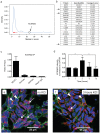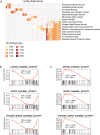The long non-coding RNA NEAT1 is responsive to neuronal activity and is associated with hyperexcitability states
- PMID: 28054653
- PMCID: PMC5214838
- DOI: 10.1038/srep40127
The long non-coding RNA NEAT1 is responsive to neuronal activity and is associated with hyperexcitability states
Abstract
Despite their abundance, the molecular functions of long non-coding RNAs in mammalian nervous systems remain poorly understood. Here we show that the long non-coding RNA, NEAT1, directly modulates neuronal excitability and is associated with pathological seizure states. Specifically, NEAT1 is dynamically regulated by neuronal activity in vitro and in vivo, binds epilepsy-associated potassium channel-interacting proteins including KCNAB2 and KCNIP1, and induces a neuronal hyper-potentiation phenotype in iPSC-derived human cortical neurons following antisense oligonucleotide knockdown. Next generation sequencing reveals a strong association of NEAT1 with increased ion channel gene expression upon activation of iPSC-derived neurons following NEAT1 knockdown. Furthermore, we show that while NEAT1 is acutely down-regulated in response to neuronal activity, repeated stimulation results in NEAT1 becoming chronically unresponsive in independent in vivo rat model systems relevant to temporal lobe epilepsy. We extended previous studies showing increased NEAT1 expression in resected cortical tissue from high spiking regions of patients suffering from intractable seizures. Our results indicate a role for NEAT1 in modulating human neuronal activity and suggest a novel mechanistic link between an activity-dependent long non-coding RNA and epilepsy.
Figures




References
-
- Barry G. Integrating the roles of long and small non-coding RNA in brain function and disease. Mol Psychiatry. 19, 410–416 (2014). - PubMed
-
- Briggs J. A., Wolvetang E. J., Mattick J. S., Rinn J. L. & Barry G. Mechanisms of Long Non-coding RNAs in Mammalian Nervous System Development, Plasticity, Disease, and Evolution. Neuron. 88, 861–877 (2015). - PubMed
MeSH terms
Substances
Grants and funding
LinkOut - more resources
Full Text Sources
Other Literature Sources
Medical
Molecular Biology Databases

